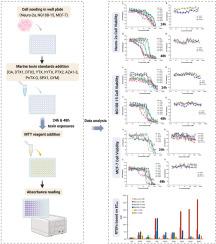Lipophilic marine toxins effects on Neuro-2a, NG108-15 and MCF-7 cell lines
IF 2.4
4区 医学
Q2 PHARMACOLOGY & PHARMACY
引用次数: 0
Abstract
Okadaic acid (OA), dinophysistoxin-1 (DTX1), dinophysistoxin-2 (DTX2), yessotoxin (YTX), 1-homoyessotoxin (hYTX), pectenotoxin-2 (PTX2), azaspiracid-1 (AZA1), azaspiracid-2 (AZA2), azaspiracid-3 (AZA3), pinnatoxin-G (PnTX-G), spirolide (SPX1) and gymnodimine (GYM) are lipophilic marine toxins (LMTs), which are harmful to humans and also possess potential therapeutic applications. To compare the toxicity and medical value of LMTs, Neuro-2a, NG108-15 and MCF-7 cell lines were employed to test cytotoxicity under the same conditions and toxin concentrations. These results showed OA, DTX1, DTX2, YTX, hYTX, PTX2, AZA1, AZA2 and AZA3 were cytotoxic in all tested cell types. However, PnTX-G, SPX1 and GYM had no effect on the three cell lines at 0.01–1000 nM. The sensitivity sequences based on EC50 values of the three cell lines to OA, DTX1, DTX2, YTX, hYTX, PTX2, AZA1, AZA2 and AZA3 were confirmed at 24 h and 48 h of exposure. Neuro-2a cell line was sensitive to AZA3, AZA2, AZA1; NG108-15 to YTX, hYTX and PTX2; and MCF-7 to DTX1. These data provided a scientific basis for calculating the toxicity equivalency factors (TEFs) of the OA, DTX1, DTX2, YTX, hYTX, PTX2, AZA1, AZA2 and AZA3 based on cytotoxicity, and possess an application value for further development of anti-tumor drugs.

亲脂性海洋毒素对神经2a、NG108-15和MCF-7细胞系的影响
冈田酸(OA)、甲藻毒素-1 (DTX1)、甲藻毒素-2 (DTX2)、叶梭毒素(YTX)、1-同源叶梭毒素(hYTX)、果皮毒素-2 (PTX2)、氮扎斯酸-1 (AZA1)、氮扎斯酸-2 (AZA2)、氮扎斯酸-3 (AZA3)、品纳毒素- g (PnTX-G)、螺环内酯(SPX1)和裸子二胺(GYM)是对人体有害的亲脂性海洋毒素(lmt),具有潜在的治疗价值。为了比较LMTs的毒性和医学价值,在相同的条件和毒素浓度下,采用neuro2a、NG108-15和MCF-7细胞系进行细胞毒性测试。结果显示OA、DTX1、DTX2、YTX、hYTX、PTX2、AZA1、AZA2、AZA3对所有细胞均有细胞毒性。而PnTX-G、SPX1和GYM在0.01 ~ 1000 nM对3株细胞系均无影响。根据3种细胞系在暴露24 h和48 h时的EC50值确定对OA、DTX1、DTX2、YTX、hYTX、PTX2、AZA1、AZA2和AZA3的敏感性序列。神经-2a细胞系对AZA3、AZA2、AZA1敏感;NG108-15到YTX, hYTX和PTX2;MCF-7转DTX1。这些数据为基于细胞毒性计算OA、DTX1、DTX2、YTX、hYTX、PTX2、AZA1、AZA2、AZA3的毒性等效因子(TEFs)提供了科学依据,对进一步开发抗肿瘤药物具有应用价值。
本文章由计算机程序翻译,如有差异,请以英文原文为准。
求助全文
约1分钟内获得全文
求助全文
来源期刊

Toxicon
医学-毒理学
CiteScore
4.80
自引率
10.70%
发文量
358
审稿时长
68 days
期刊介绍:
Toxicon has an open access mirror Toxicon: X, sharing the same aims and scope, editorial team, submission system and rigorous peer review. An introductory offer Toxicon: X - full waiver of the Open Access fee.
Toxicon''s "aims and scope" are to publish:
-articles containing the results of original research on problems related to toxins derived from animals, plants and microorganisms
-papers on novel findings related to the chemical, pharmacological, toxicological, and immunological properties of natural toxins
-molecular biological studies of toxins and other genes from poisonous and venomous organisms that advance understanding of the role or function of toxins
-clinical observations on poisoning and envenoming where a new therapeutic principle has been proposed or a decidedly superior clinical result has been obtained.
-material on the use of toxins as tools in studying biological processes and material on subjects related to venom and antivenom problems.
-articles on the translational application of toxins, for example as drugs and insecticides
-epidemiological studies on envenoming or poisoning, so long as they highlight a previously unrecognised medical problem or provide insight into the prevention or medical treatment of envenoming or poisoning. Retrospective surveys of hospital records, especially those lacking species identification, will not be considered for publication. Properly designed prospective community-based surveys are strongly encouraged.
-articles describing well-known activities of venoms, such as antibacterial, anticancer, and analgesic activities of arachnid venoms, without any attempt to define the mechanism of action or purify the active component, will not be considered for publication in Toxicon.
-review articles on problems related to toxinology.
To encourage the exchange of ideas, sections of the journal may be devoted to Short Communications, Letters to the Editor and activities of the affiliated societies.
 求助内容:
求助内容: 应助结果提醒方式:
应助结果提醒方式:


